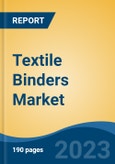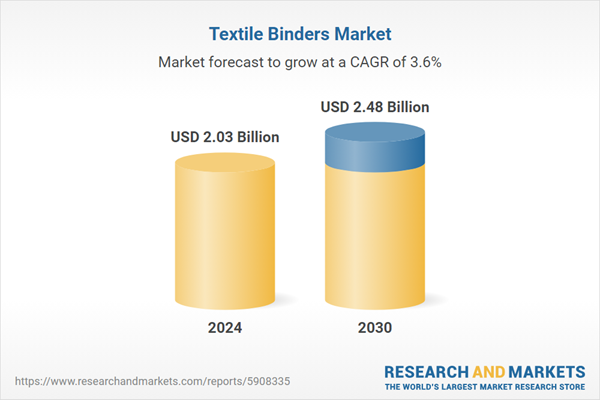Speak directly to the analyst to clarify any post sales queries you may have.
10% Free customizationThis report comes with 10% free customization, enabling you to add data that meets your specific business needs.
Key Market Drivers
Growing Trend of Sustainable Textiles is major factor for Textile Binders Market Growth
The global textile binders market is witnessing significant growth, primarily driven by the accelerating shift toward sustainable textiles. As environmental concerns surrounding the textile industry intensify, the demand for eco-friendly binders is surging. Traditionally, textile manufacturing relied heavily on synthetic binders, which contribute to pollution and waste through the release of volatile organic compounds (VOCs) and non-biodegradable residues. However, the industry is undergoing a transformation, moving toward greener alternatives that align with global sustainability goals.Eco-friendly textile binders, such as water-based acrylics, polyurethane dispersions, and natural polymer-based formulations, are gaining traction. These binders are designed to be biodegradable, non-toxic, and low in VOC emissions, significantly reducing the environmental footprint of textile production. This shift is reinforced by government regulations. For instance, the European Union’s REACH regulation and similar directives in North America and Asia are encouraging textile producers to eliminate harmful substances and adopt sustainable manufacturing practices.
Consumer awareness is another strong growth catalyst. According to a 2023 report, over 67% of global consumers consider sustainability when purchasing apparel. This rising preference for ethically produced textiles is pushing brands to prioritize eco-friendly sourcing. Consequently, fashion giants such as H&M, Patagonia, and Adidas are committing to sustainable supply chains and materials, including the use of green binders.
Asia-Pacific, led by China, India, and Bangladesh, remains the largest market for textile binders due to its dominant role in textile production. However, sustainable product adoption is increasing rapidly across European and North American textile hubs as brands and suppliers align with ESG goals. Technological innovations are enhancing binder performance, enabling eco-friendly products to meet rigorous textile quality standards, such as strength, durability, and colorfastness. The growing demand for sustainable textiles is a major driver of the global textile binders market. Backed by regulatory support, rising consumer awareness, and industry innovation, eco-friendly binders are becoming a core element in the textile value chain, propelling continued market expansion in the years ahead.
Key Market Challenges
Regulatory Compliance
Regulatory compliance is proving to be a substantial impediment to the growth of the global Textile Binders market. Textile binders are essential components in the textile industry, serving as crucial agents for fabric printing, finishing, and stabilization. However, stringent regulations regarding environmental and chemical safety are driving changes in binder formulations and manufacturing processes.To comply with these regulations, manufacturers must invest in research and development to create binder solutions that are free from hazardous chemicals and meet eco-friendly criteria. This transition often requires significant resources and can result in higher production costs. The approval and certification processes for new binder formulations can be time-consuming and may delay market entry.
To navigate these challenges and foster growth in the Textile Binders market, companies are focusing on sustainable and compliant binder formulations. Collaboration with regulatory authorities, adoption of environmentally friendly technologies, and transparent communication regarding product safety are becoming increasingly important. By embracing these strategies, businesses can not only meet regulatory standards but also tap into the growing demand for eco-conscious textile solutions, thereby driving market expansion.
Key Market Trends
Rising demand for Green Binders
The rising demand for green binders represents a pivotal trend propelling the growth of the global Textile Binders market. In a world increasingly focused on sustainability, the textile industry is undergoing a transformation towards eco-friendly practices. Green binders, also known as environmentally friendly binders, have become essential in this shift as they are formulated with reduced levels of harmful chemicals and exhibit minimal environmental impact throughout their lifecycle.Consumers are now more conscious of the environmental footprint of their clothing, and this has driven textile manufacturers to seek sustainable solutions. Green binders offer reduced emissions, lower energy consumption, and are often made from renewable or recycled materials, aligning perfectly with the principles of sustainable fashion. As regulatory pressures and consumer preferences continue to push the textile industry towards eco-consciousness, the demand for green binders is on the rise.
This trend opens up significant growth opportunities for companies in the Textile Binders market that can provide innovative, sustainable binder solutions to meet the evolving demands of the textile industry, ultimately contributing to a more environmentally responsible and sustainable textile production landscape.
Key Market Players
- Archroma Corporate
- Fineotex Group
- Dow Co.
- Camex Ltd.
- OMNOVA Solutions Inc.
- Arkema SA
- Organic Dyes and Pigments LLC
- Pioneer Chemicals Inc
- Scott Bader Company Ltd
- Hemanjali Polymers Pvt. Ltd
Report Scope:
In this report, the Global Textile Binders Market has been segmented into the following categories, in addition to the industry trends which have also been detailed below:Textile Binders Market, By Material:
- Acrylic Copolymer
- Styrene Acrylate Copolymer
- Vinyl Acrylate Copolymer
- Other
Textile Binders Market, By Application:
- Flocking
- Fabric Coating & Printing
- Lamination
- Others
Textile Binders Market, By Region:
- Asia-Pacific
- China
- India
- Japan
- Australia
- South Korea
- North America
- United States
- Canada
- Mexico
- Europe
- France
- United Kingdom
- Italy
- Germany
- Spain
- South America
- Brazil
- Argentina
- Colombia
- Middle East & Africa
- South Africa
- Saudi Arabia
- UAE
- Qatar
- Turkey
- Egypt
Competitive Landscape
Company Profiles: Detailed analysis of the major companies present in the Global Textile Binders Market.Available Customizations:
With the given market data, the publisher offers customizations according to a company's specific needs. The following customization options are available for the report.Company Information
- Detailed analysis and profiling of additional market players (up to five).
This product will be delivered within 1-3 business days.
Table of Contents
Companies Mentioned
- Archroma Corporate
- Fineotex Group
- Dow Co.
- Camex Ltd.
- OMNOVA Solutions Inc.
- Arkema SA
- Organic Dyes and Pigments LLC
- Pioneer Chemicals Inc
- Scott Bader Company Ltd
- Hemanjali Polymers Pvt. Ltd
Table Information
| Report Attribute | Details |
|---|---|
| No. of Pages | 185 |
| Published | August 2025 |
| Forecast Period | 2024 - 2030 |
| Estimated Market Value ( USD | $ 2.03 Billion |
| Forecasted Market Value ( USD | $ 2.48 Billion |
| Compound Annual Growth Rate | 3.5% |
| Regions Covered | Global |
| No. of Companies Mentioned | 10 |









